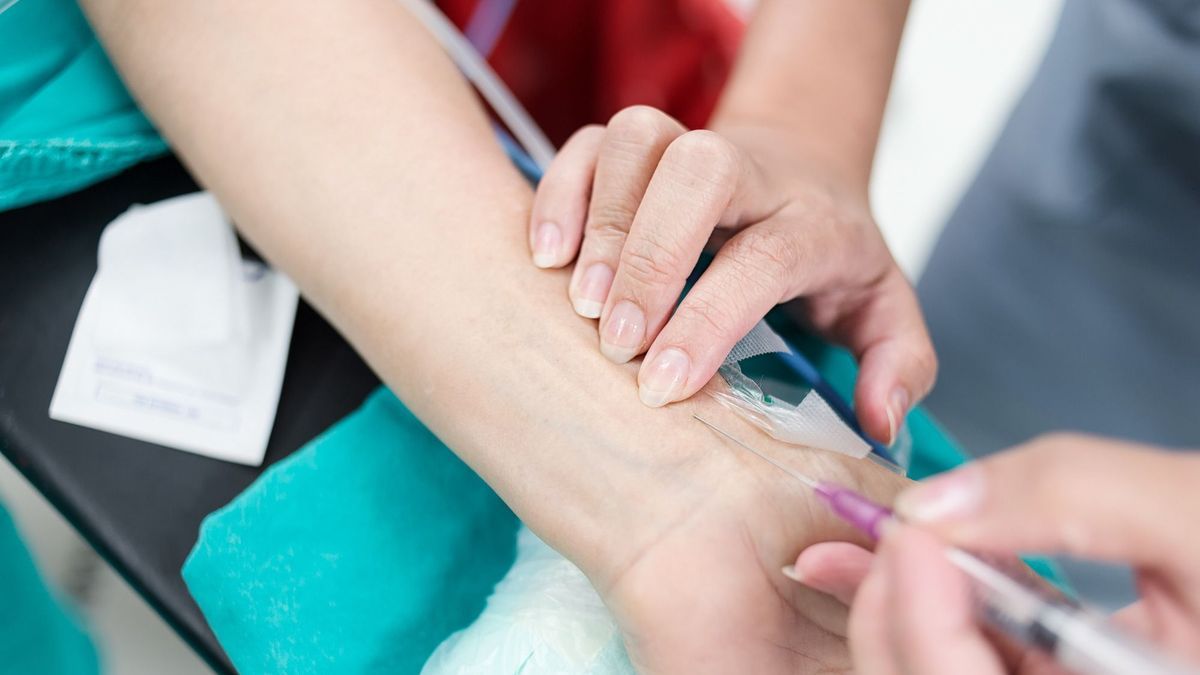
Published on
Updated
This test measures the levels of oxygen and carbon dioxide in the arterial blood and determines the acidity (pH) of the blood. What are the indications for this examination? What are the results ? Are there any side effects? Update with Doctor Sabine Tack, pulmonologist.
What is arterial gasometry?
Gasometry is an examination which consists of puncturing the artery (most often theradial artery therefore in the hollow of the wrist), arterial blood in which partial pressures of oxygen and carbon dioxide will be measured as well as the pH of the blood. “These are the three most important measurements to check in a sample of oxygenated blood leaving the heart. specifies Doctor Sabine Tack, pulmonologist. “It is a reflection of the proper functioning of the lung since the lung is the organ responsible for oxygenating the blood and releasing carbon dioxide, waste produced by the production of energy in our body.”
Why do an arterial blood gas?
Blood gas testing is usually performed if respiratory illness is suspected. “If a person is out of breath during exercise or at rest, the pulmonologist will measure this oxygen pressure to check if the blood is poorly oxygenated, which would be a sign of a respiratory disease of the lungs and bronchi. indicates the pulmonologist. “The most common disease is COPD (Chronic Obstructive Pulmonary Disease), a chronic disease which, over the years, ends up blocking the bronchi, most often due to smoking. The air has difficulty reaching the pulmonary alveolus, the place where gas exchange with the blood takes place.
Other respiratory diseases may also require blood gas testing but are rarer, such as pulmonary fibrosisa disease that destroys the lung through a process of fibrosis.
It is essentially shortness of breath during exercise that will lead a doctor to prescribe this type of test.
Gasometry can also be carried out in cases of kidney pathology such as diabetic decompensation, a renal failure. “There are indeed diseases which are responsible for acidosis (blood acidity)”, confirms the specialist. “The gasometry determines the pH and therefore the acidity, recalls the specialist. The normal pH of the blood is 7.4. If it is acidic it is approximately 7.29 – 7.30”.
In children, gas measurements are used in cases of acute pulmonary pathologies (pneumonia) and in cases of chronic illnesses such as cystic fibrosis. Gasometry is not carried out in the event of a crisis.asthma in children.
In an emergency, we may need to request additional CT angiography if a pulmonary embolism is suspected. “Pulmonary embolism corresponds to a blood clot that migrates through the venous network into the right ventricle of the heart, describes the pulmonologist. This clot will then block a branch of the pulmonary artery and then create a hypoxia very severe”.
If it is not an emergency and the patient is being monitored over a long period of time, pulmonary function testing remains the key test. The patient blows in an isolated cabin to test his lung capacity. The examination is completed, once a year, generally in addition to the gas analysis, with a CT scan.
How is an arterial blood gas measurement carried out?
Gasometry is carried out in the pulmonologist’s office or in the intensive care unit of the hospital. Beforehand, the pulmonologist, wearing a glove, disinfects the patient’s wrist, identifies the radial pulse, and pricks at an angle with a very fine needle. The blood rises on its own in the syringe thanks to the pressure generated by the arterial system. Once collected, the blood is immediately injected into the analyzer specifying in a few minutes the pH, PCO2, PaO2, lactates (marker of muscle exhaustion), hemoglobin, potassium, bicarbonate, etc. “PCO2 and bicarbonates are also a reflection of the body’s carbon dioxide load if the lung does not function properly in spitting out carbon dioxide,” indicates the specialist.
What results after an arterial gasometry?
If this is a patient regularly monitored by their pulmonologist, gas analysis makes it possible to check the progression of the disease (worsening or attenuation). Depending on the result, the patient may be placed on oxygen if the PaO2 is low. If the respiratory disease is chronic, two PaO 2 measurements below 55 mmHg (millimeter of mercury) will be necessary to place the patient on oxygen.
What are the side effects of arterial blood gas monitoring?
It is not possible to prick several times to sharpen a patient. Gasometry is a painful procedure which can also create hematomas. The pain of gas measurement can, however, be reduced by applying a dressing containing local anesthetics, half an hour before the injection. “Let’s not forget that we are in high pressure blood circulation”, explains Doctor Sabine Tack. “In the body there are two blood circulations: arterial (high pressure) and venous (low pressure)”, recalls- her. “It also happens that we cannot find the artery, especially when the arteries are damaged (in diabetics, hypertensives). We then prick into another pulse for example thefemoral artery in the hollow of the thigh.
There is an alternative, called capillary gasometry. “It is extremely valuable because it is painless. rejoices Doctor Sabine Tack. “We can therefore perform it as many times as we want. Capillary gasometry consists of putting a little vasodilator ointment on the earlobe. The ear becomes red and swollen. We prick with a painless lancet then we collects a little blood. This measurement is reliable for ph, PCO2 but less so for PaO2”.
